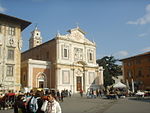Baths of Nero (Pisa)
Ancient Roman baths in ItalyBuildings and structures in PisaRoman sites of Tuscany

The Baths of Nero (Italian - Bagni di Nerone) are an archaeological site near the Porta a Lucca in Pisa, then the Roman city of Colonia Pisana. Now below street level, they are the only Roman remains still standing in the city and form a thermae complex.
Excerpt from the Wikipedia article Baths of Nero (Pisa) (License: CC BY-SA 3.0, Authors, Images).Baths of Nero (Pisa)
Largo del Parlascio, Pisa Porta a Lucca
Geographical coordinates (GPS) Address External links Nearby Places Show on map
Geographical coordinates (GPS)
| Latitude | Longitude |
|---|---|
| N 43.72226 ° | E 10.40198 ° |
Address
Bagni di Nerone
Largo del Parlascio
56126 Pisa, Porta a Lucca
Tuscany, Italy
Open on Google Maps







